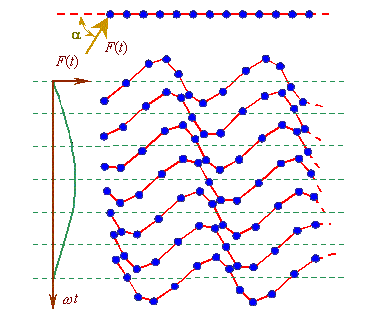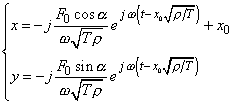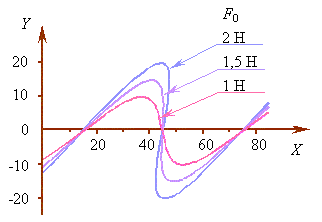| MATERIALS. TECHNOLOGIES. TOOLS | 14 |
| S.B. Karavashkin | |
|
|
Each of these systems is similar to those considered in [1]. So we can write directly the exact analytical solutions for each of them, as follows: for the x-component of vibration: in the periodical regime ( |
|
| (3) | |
| in the
aperiodical regime ( |
|
|
(4) |
| and in that
critical ( |
|
|
(5) |
For the y-component of vibrations we yield relatively: in the periodical regime ( |
|
|
(6) |
| in the
aperiodical regime ( |
|
|
(7) |
| and in that
critical ( |
|
|
(8) |
where As the result of superposition, there forms an inclined wave propagating with the positive axis x; this is corroborated by the vibration diagram shown in Fig. 2. |
|
Fig. 2. Vibration in a semi-finite line under affection of
the force inclined to the line axis. The line parameters: m - 0,01 kg,s
= 100 N/m, a = 0,01 m, |
|
Typically, the vibrations remain inclined pattern both with free vibrations in a lumped line and with the limiting process to a distributed line. Basing on results presented in [1], the solution - e.g., for free vibrations - the sought solution will have the following form: for the x- component of vibrations |
|
|
(9) |
| and for the y-component | |
|
(10) |
where Xk and Yk are the x- and y-components of vibration amplitude of the kth element whose parameters were specified, and k in this case is the number of element whose vibration was specified. In case of limiting process to a distributed line we can present, like in [3], |
|
|
|
where |
|
|
(11) |
This system describes parametrically an inclined wave propagation along the axis x, as is shown in Fig. 3. |
|
Fig. 3. Vibrations in a distributed line whose start is
affected by an external force inclined by the angle
|
|


